Historical Arable Land Change in an Eco-Fragile Area: A Case Study in Zhenlai County, Northeastern China
Abstract
1. Introduction
2. Materials and Methods
2.1. Study Area
2.2. Data Collection and Processing
2.3. Methodology
2.3.1. Gravity-Center Model
2.3.2. Proxy-Based Reconstruction Method
2.3.3. GIS-Based Analysis Methodology
3. Results
3.1. Settlement Change According to Zhenlai Gazetteer
3.2. Land Development and Transformation Process
3.3. Settlement as a Proxy for Historical Arable Land Reconstruction
3.3.1. Calculation of Farming Radius Adopting Two Methods Based on Data from Topographic Maps
3.3.2. Historical Arable Land Reconstruction Based on Settlements and Farming Radius
4. Discussion
5. Conclusions
Author Contributions
Funding
Conflicts of Interest
References
- International Geosphere-Biosphere Programme (IGBP). Global Change and Earth System: A Planet Under Pressure; IGBP Science Series; IGBP: Stockholm, Swedish, 2001; p. 4. [Google Scholar]
- Ramankutty, N.; Foley, J.A. Estimating historical changes in global land cover: Croplands from 1700 to 1992. Glob. Biogeochem. Cycles 1999, 13, 997–1027. [Google Scholar] [CrossRef]
- Goldewijk, K.K.; Verburg, P.H. Uncertainties in global-scale reconstructions of historical land use: An illustration using the HYDE data set. Landsc. Ecol. 2013, 28, 861–877. [Google Scholar] [CrossRef]
- Fuchs, R.; Herold, M.; Verburg, P.H.; Clevers, J.G.P.W.; Eberle, J. Gross changes in reconstructions of historic land cover/use for Europe between 1900 and 2010. Glob. Chang. Boil. 2015, 21, 299–313. [Google Scholar] [CrossRef] [PubMed]
- Fuchs, R. A Data–Driven Reconstruction of Historic Land Cover/Use Change of Europe for the Period 1900 to 2010; Wageningen University: Wageningen, The Netherlands, 2015. [Google Scholar]
- Petit, C.C.; Lambin, E.F. Impact of data integration technique on historical land-use/land-cover change: Comparing historical maps with remote sensing data in the Belgian Ardennes. Landsc. Ecol. 2002, 17, 117–132. [Google Scholar] [CrossRef]
- Turner, B.L.; Skole, D.L.; Sanderson, S.; Fischer, G.; Fresco, L.; Leemans, R. Land-Use and Land-Cover Change: Science/Research Plan; Report 35; International Geosphere-Biosphere Programme: Stockholm, Swedish, 1995. [Google Scholar]
- Leite, C.C.; Costa, M.H.; Soares-Filho, B.S.; de Barros Viana Hissa, L.C. Historical land use change and associated carbon emissions in Brazil from 1940 to 1995. Glob. Biogeochem. Cycles 2012, 26. [Google Scholar] [CrossRef]
- Chang-Martínez, L.A.; Mas, J.F.; Valle, N.T.; Torres, P.S.U.; Folan, W.J. Modeling Historical Land Cover and Land Use: A Review from Contemporary Modeling. ISPRS Int. J. Geo-Inf. 2015, 4, 1791–1812. [Google Scholar] [CrossRef]
- Goldewijk, K.K.; Beusen, A.; Janssen, P. Long-term dynamic modeling of global population and built-up area in a spatially explicit way: HYDE 3.1. Holocene 2010, 20, 565–573. [Google Scholar] [CrossRef]
- Goldewijk, K.K.; Beusen, A.; Drecht, G.V.; De Vos, M. The HYDE 3.1 spatially explicit database of human–induced global land–use change over the past 12,000 years. Glob. Ecol. Biogeogr. 2011, 20, 73–86. [Google Scholar] [CrossRef]
- Hurtt, G.C.; Chini, L.P.; Frolking, S.; Betts, R.A.; Feddema, J.; Fischer, G.; Fisk, J.P.; Hibbard, K.; Houghton, R.A.; Janetos, A.; et al. Harmonization of land–use scenarios for the period 1500–2100: 600 years of global gridded annual land–use transitions, wood harvest, and resulting secondary lands. Clim. Chang. 2011, 109, 117–161. [Google Scholar] [CrossRef]
- Olofsson, J.; Hickler, T. Effects of human land-use on the global carbon cycle during the last 6000 years. Veget. Hist. Archaeobot. 2008, 17, 605–615. [Google Scholar] [CrossRef]
- Yang, Y.Y.; Zhang, S.W.; Yang, J.C.; Bu, K.; Xing, X.X. A review of historical reconstruction methods of land use/land cover. J. Geogr. Sci. 2014, 24, 746–766. [Google Scholar] [CrossRef]
- Boucher, Y.; Arseneault, D.; Sirois, L.; Blais, L. Logging pattern and landscape changes over the last century at the boreal and deciduous forest transition in Eastern Canada. Landsc. Ecol. 2009, 24, 171–184. [Google Scholar] [CrossRef]
- Hamre, L.N.; Domaas, S.T.; Austad, I.; Rydgren, K. Land–cover and structural changes in a western Norwegian cultural landscape since 1865, based on an old cadastral map and a field survey. Landsc. Ecol. 2007, 22, 1563–1574. [Google Scholar] [CrossRef]
- Hurtt, G.C.; Frolking, S.; Fearon, M.G.; Moore, B.; Shevliakova, E.; Malyshev, S.; Pacala, S.w.; Houghton, R.A. The underpinnings of land–use history: Three centuries of global gridded land-use transitions, wood–harvest activity, and resulting secondary lands. Glob. Chang. Biol. 2006, 12, 1208–1229. [Google Scholar] [CrossRef]
- Kumar, S.; Merwade, V.; Rao, P.S.C.; Pijanowski, B.C. Characterizing Long–Term Land Use/Cover Change in the United States from 1850 to 2000 Using a Nonlinear Bi–analytical Model. AMBIO 2013, 42, 285–297. [Google Scholar] [CrossRef] [PubMed]
- Pongratz, J.; Reick, C.; Raddatz, T.; Claussen, M. A reconstruction of global agricultural areas and land cover for the last millennium. Glob. Biogeochem. Cycles 2008, 22. [Google Scholar] [CrossRef]
- Wulf, M.; Sommer, M.; Schmidt, R. Forest cover changes in the Prignitz region (NE Germany) between 1790 and 1960 in relation to soils and other driving forces. Landsc. Ecol. 2010, 25, 299–313. [Google Scholar] [CrossRef]
- García-Ayllón, S. Retro-diagnosis methodology for land consumption analysis towards sustainable future scenarios: Application to a mediterranean coastal area. J. Clean. Prod. 2018, 195, 1408–1421. [Google Scholar] [CrossRef]
- García-Ayllón, S. Predictive Diagnosis of Agricultural Periurban Areas Based on Territorial Indicators: Comparative Landscape Trends of the So-Called “Orchard of Europe”. Sustainability 2018, 10, 1820. [Google Scholar] [CrossRef]
- Wulf, M.; Rujner, H. A GIS–based method for the reconstruction of the late eighteenth century forest vegetation in the Prignitz region (NE Germany). Landsc. Ecol. 2011, 26, 153–168. [Google Scholar] [CrossRef]
- Bürgi, M.; Hersperger, A.M.; Hall, M.; Southgate, E.W.; Schneeberger, N. Using the past to understand the present land use and land cover. In A Changing World; Kienast, F., Wildi, O., Ghosh, S., Eds.; Springer: Cham, The Netherlands, 2007; pp. 133–144. [Google Scholar]
- He, F.N.; Li, S.C.; Zhang, X.Z. The reconstruction of cropland area and its spatial distribution pattern in the mid–northern Song dynasty. Acta Geogr. Sin. 2011, 66, 1531–1539. (In Chinese) [Google Scholar]
- Zeng, Z.Z.; Fang, X.Q.; Ye, Q. The Process of Land Cultivation Based on Settlement Names in Jilin Province in the Past 300 Years. Acta Geogr. Sin. 2011, 66, 985–993. (In Chinese) [Google Scholar]
- Yang, Y.Y.; Zhang, S.W.; Wang, D.Y.; Yang, J.C.; Xing, X.S. Spatiotemporal changes of farming-pastoral ecotone in Northern China, 1954–2005: A case study in Zhenlai County, Jilin Province. Sustainability 2014, 7, 1–22. [Google Scholar] [CrossRef]
- de Sherbinin, A. A Guide to Land-Use and Land-Use Cover Change (LUCC); A Collaborative Effort of SEDAC and the IGBP/IHDP LUCC Project; Columbia University: New York, NY, USA, 2002. [Google Scholar]
- Xie, R.Q.; Liu, F.M. Study on changes in landscape pattern of land use based on fractal theory-a case study of Zhenlai Town of Zhenlai County. Res. Soil Water Conserv. 2013, 20, 217–222. (In Chinese) [Google Scholar]
- Zhang, G.K.; Song, K.S.; Zhang, S.Q.; Liang, Y.H. The change of landscape pattern in Zhenlai Xian, Jilin Province in recent ten years. Acta Ecol. Sin. 2012, 32, 3958–3965. (In Chinese) [Google Scholar] [CrossRef]
- Cui, H.S.; Zhang, B.; Liu, X.N. Forecast of land desertification in northern Jilin province of China. J. Desert Res. 2004, 24, 235–239. (In Chinese) [Google Scholar]
- Geographical Names Committee Office of Zhenlai County. Zhenlai Gazetteer, Zhenlai County People’s Government; Geographical Names Committee Office of Zhenlai County: Baicheng, China. 1985. (In Chinese)
- He, F.; Li, M.; Li, S. Reconstruction of Lu-level cropland areas in the Northern Song Dynasty (AD976–1078). J. Geogr. Sci. 2017, 27, 606–618. [Google Scholar] [CrossRef]
- Fuchs, R.; Verburg, P.H.; Clevers, J.G.P.W.; Herold, M. The potential of old maps and encyclopaedias for reconstructing historic European land cover/use change. Appl. Geogr. 2015, 59, 43–55. [Google Scholar] [CrossRef]
- Liu, J.Y.; Liu, M.L.; Zhuang, D.F.; Zhang, Z.X.; Deng, X.Z. Study on spatial pattern of land-use change in China during 1995–2000. Sci. China 2003, 46, 374–384. [Google Scholar]
- He, Y.B.; Chen, Y.Q.; Tang, H.J.; Yao, Y.M.; Yang, P.; Chen, Z.X. Exploring spatial change and gravity center movement for ecosystem services value using a spatially explicit ecosystem services value index and gravity model. Environ. Monit. Assess. 2011, 175, 563–571. [Google Scholar] [CrossRef] [PubMed]
- Yang, Y.Y.; Liu, Y.S.; Li, Y.R.; Du, G.M. Quantifying spatio-temporal patterns of urban expansion in Beijing during 1985–2013 with rural-urban development transformation. Land Use Policy 2018, 74, 220–230. [Google Scholar] [CrossRef]
- Briassoulis, H. Analysis of Land Use Change: Theoretical and Modeling Approaches; West Verginia University: Morgantown, WV, USA, 2000. [Google Scholar]
- Goldewijk, K.K. Estimating global land use change over the past 300 years: The HYDE database. Glob. Biogeochem. Cycles 2001, 15, 417–433. [Google Scholar] [CrossRef]
- Ye, Q.L.; Wang, C.; Jiang, F.X.; Zhao, S.H. A farming radius-based research of clustering scale of pure agricultural rural households in hilly areas—A case study of Bailin Village, Shapingba district, Chongqing. J. Southwest Univ. Nat. Sci. Ed. 2013, 35, 1–8. (In Chinese) [Google Scholar]
- Qiao, W.F.; Wu, J.G.; Zhang, X.L.; Ji, Y.Z.; Li, H.B.; Wang, Y.H. Optimization of spatial distribution of rural settlements at county scale based on analysis of farming radius —Case study of Yongqiao district in Anhui province. Resour. Environ. Yangtze Basin 2013, 22, 1557–1563. (In Chinese) [Google Scholar]
- Jin, Q.M. Rural Settlement Geography; Science Press: Beijing, China, 1988. (In Chinese) [Google Scholar]
- Lambin, E.F.; Meyfroidt, P. Land use transitions: Socio-ecological feedback versus socio-economic change. Land Use Policy 2010, 27, 108–118. [Google Scholar] [CrossRef]
- Lv, Y.; Zhang, S.W.; Yang, J.C. Application of toponymy to the historic LUCC researches in Northeast China: Taking Zhenlai county of Jilin province as an example. J. Geo-Inf. Sci. 2010, 12, 174–179. (In Chinese) [Google Scholar]
- Lv, Y.; Zhang, S.W.; Yang, J.C. Reconstruct the spatial distribution of land use/land cover in the early reclaimed time of the western Jilin Province—Based on the GEOMOD model. J. Anhui Agric. Sci. 2015, 43, 304–308. (In Chinese) [Google Scholar]
- Fan, L.J. Immigration and Social Change in Modern Northeast China; Zhejiang University: Hangzhou, China, 2005. (In Chinese) [Google Scholar]
- Yang, Y.Y.; Zhang, S.W.; Yang, J.C.; Xing, X.S.; Wang, D.Y. Using a Cellular Automata–Markov Model to Reconstruct Spatial Land–Use Patterns in Zhenlai County, Northeast China. Energies 2015, 8, 3882–3902. [Google Scholar] [CrossRef]
- Yang, Y.Y.; Zhang, S.W.; Liu, Y.S.; Xing, X.S.; de Sherbinin, A. Analyzing historical land use changes using a Historical Land Use Reconstruction Model: A case study in Zhenlai County, northeastern China. Sci. Rep. 2017, 7, 41275. [Google Scholar] [CrossRef] [PubMed]
- Jie, D.M.; Wang, S.Z.; Guo, J.X.; Lv, J.F.; Li, J. Pollen combination and paleo-environment of Momoge Lake since 1500 years before. J. Appl. Ecol. 2004, 15, 575–578. [Google Scholar]
- Jackson, S.T.; Overpeck, J.T.; Webb-III, T.; Keattch, S.E.; Anderson, K.H. Mapped plant-macrofossil and pollen records of late Quaternary vegetation change in eastern North America. Quat. Sci. Rev. 1997, 16, 1–70. [Google Scholar] [CrossRef]
- Fritts, H.C.; Swetnam, T.W. Dendroecology: A tool for evaluating variations in past and present forest environments. Adv. Ecol. Res. 1989, 19, 111–189. [Google Scholar]
- Dahlström, A. Grazing dynamics at different spatial and temporal scales: Examples from the Swedish historical record A.D.1620–1850. Veg. Hist. Archaeobot. 2008, 17, 563–572. [Google Scholar] [CrossRef]
- Sugita, S. Pollen representation of vegetation in Quaternary sediments: Theory and method in patchy vegetation. J. Ecol. 1994, 82, 881–897. [Google Scholar] [CrossRef]



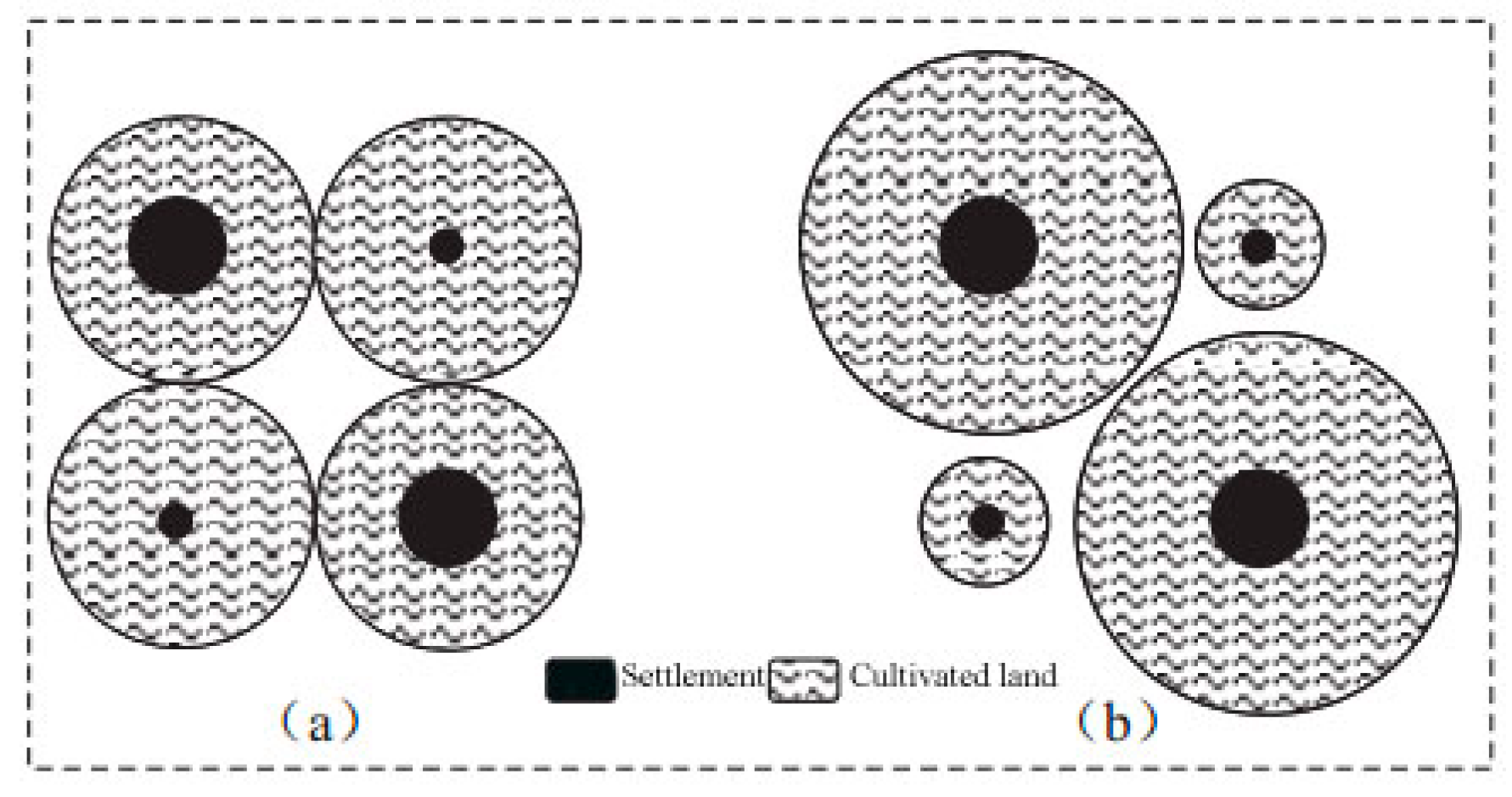


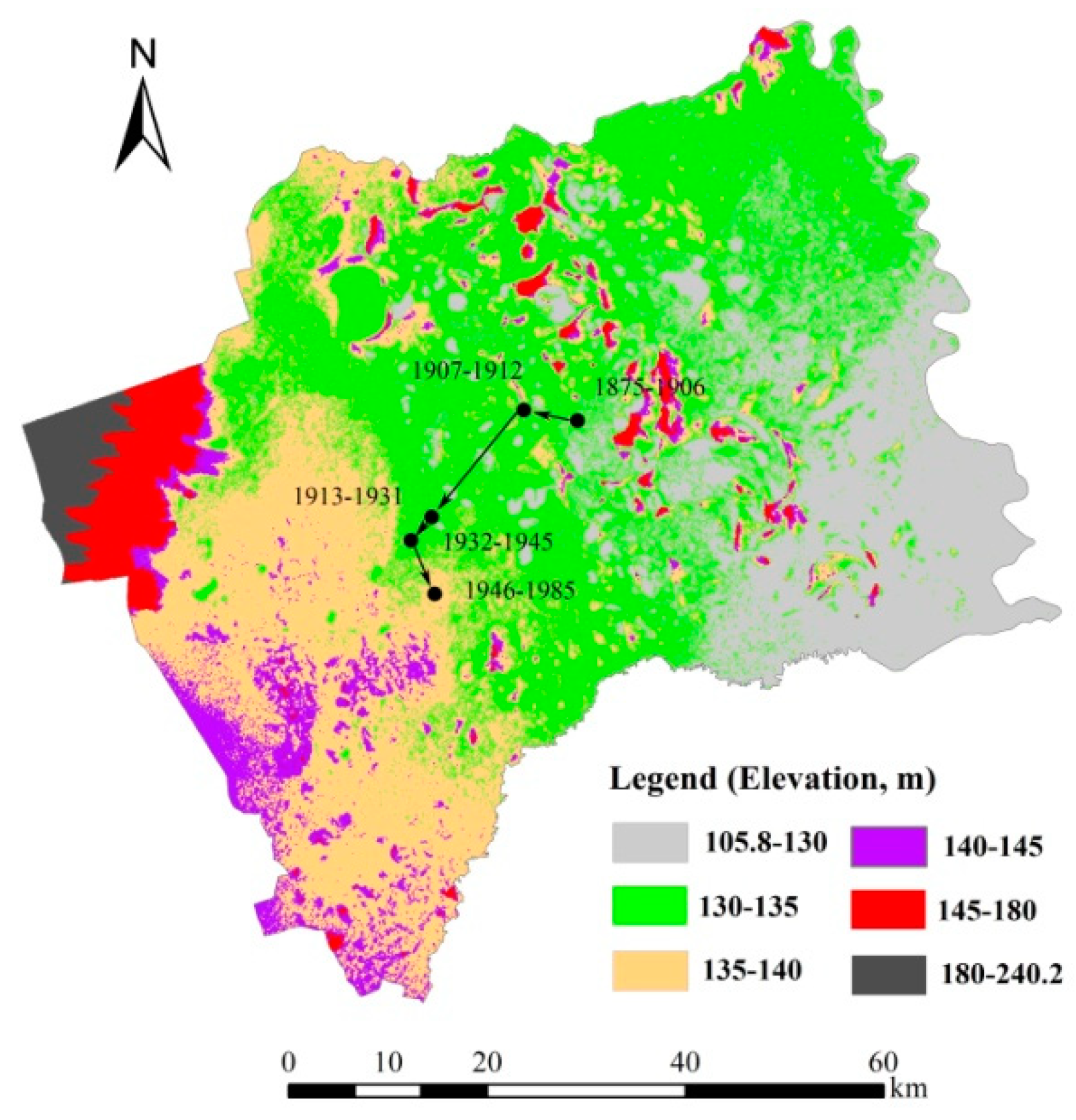



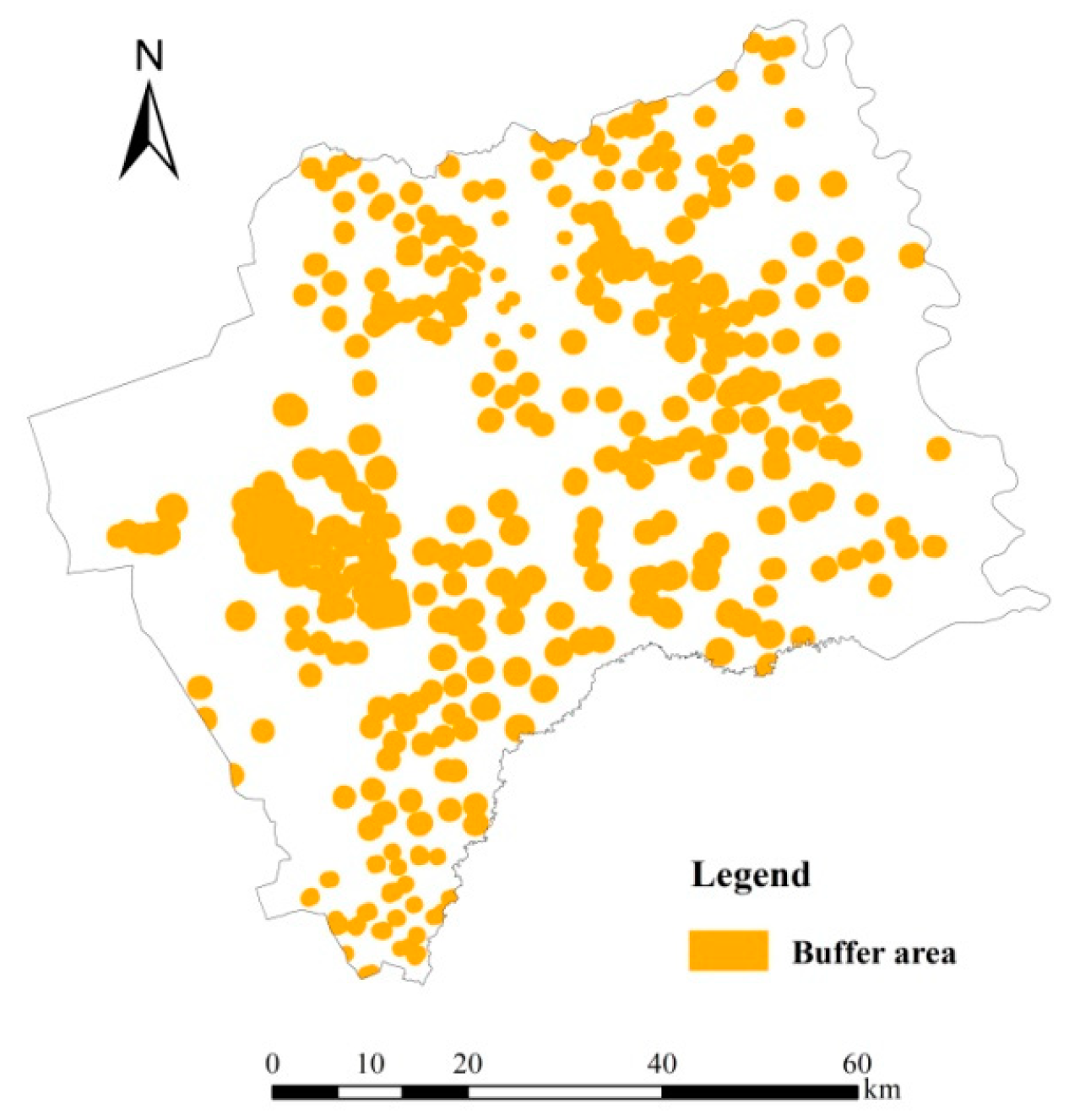
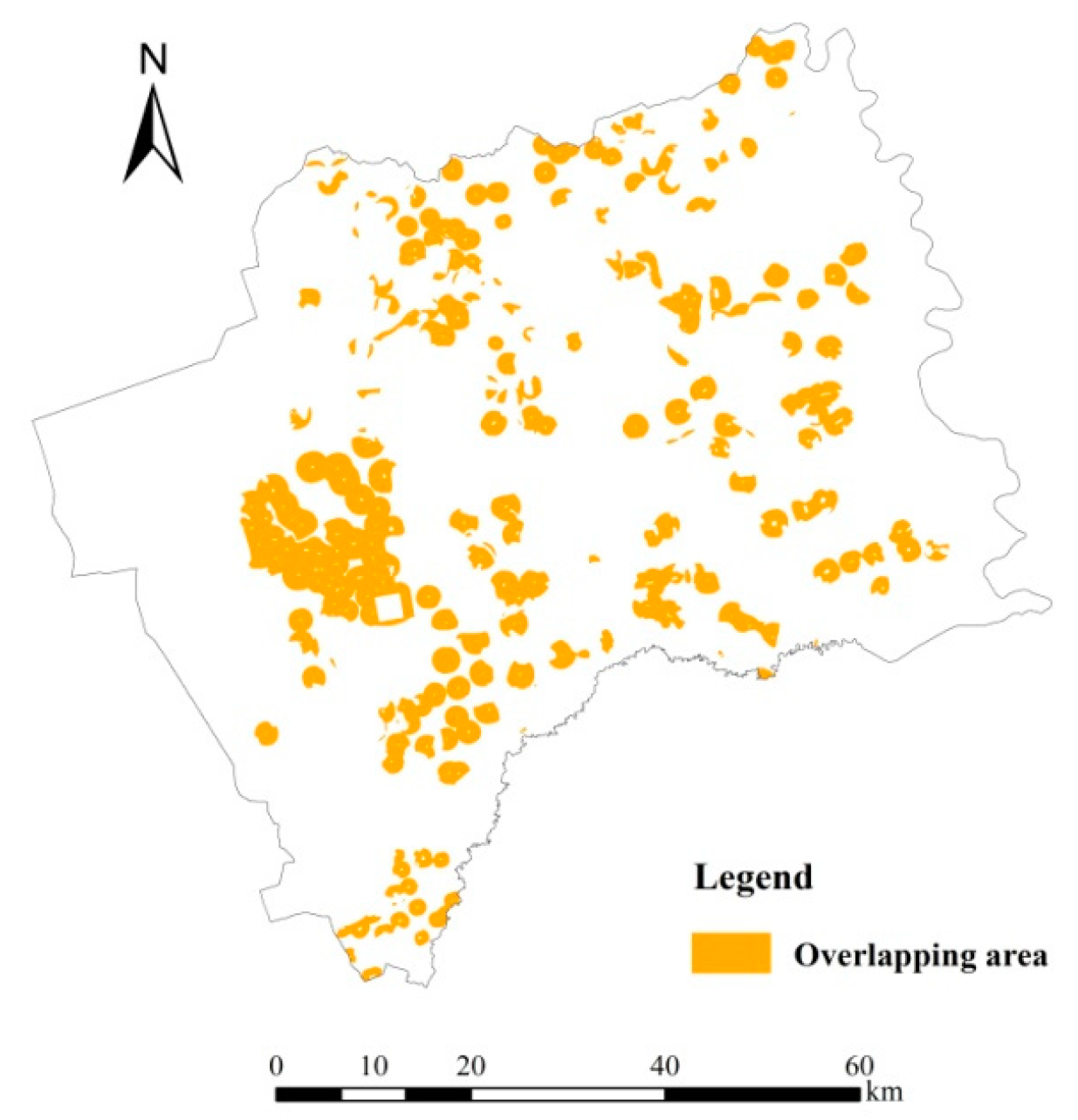
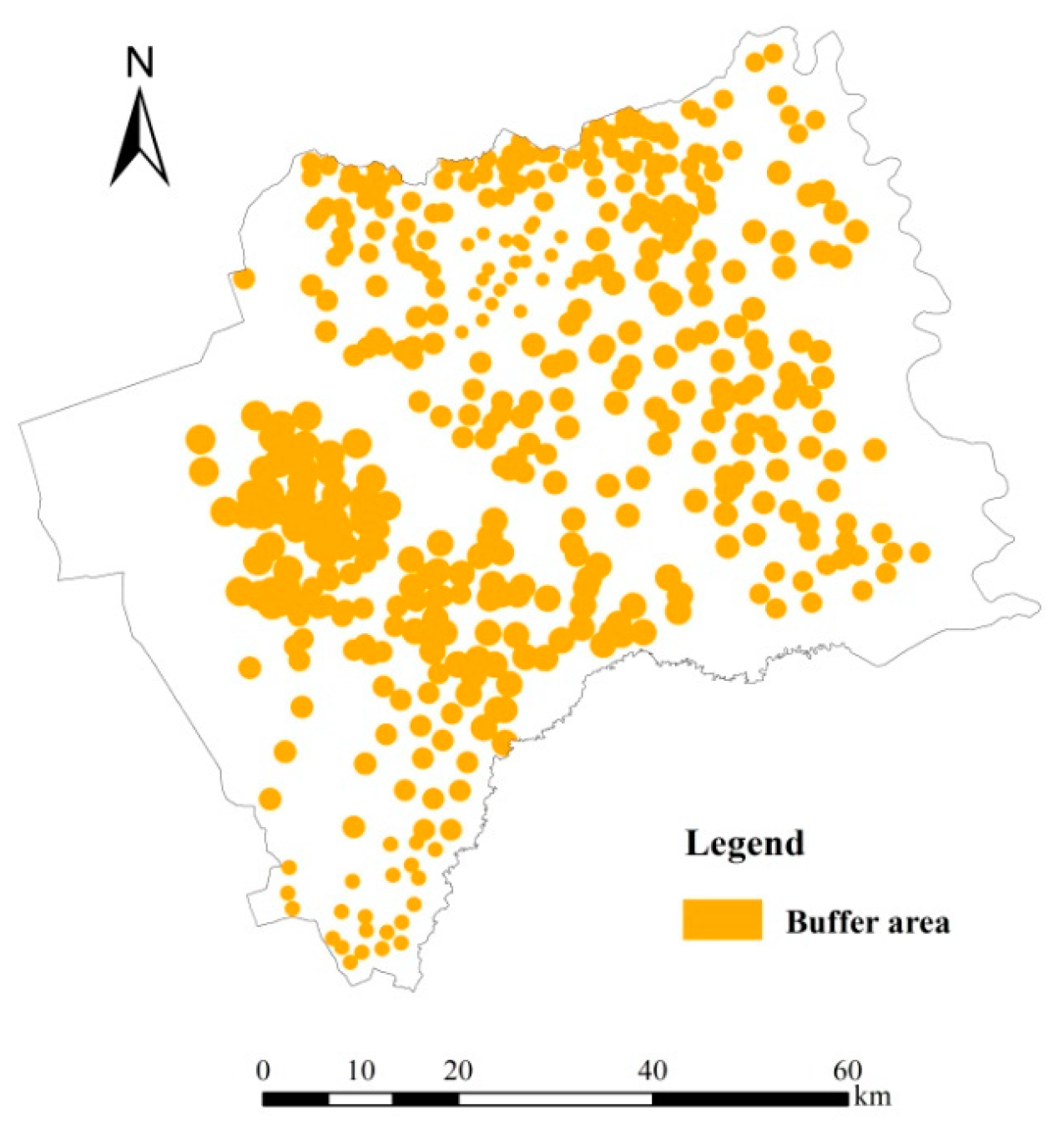

| Village Name | Year of Founding | Type of Agriculture | Ethnic Group | Number of Households in the 1980s | Population in the 1980s | Administrative Subordination |
|---|---|---|---|---|---|---|
| Baxizhao | 1875 | Nomadism | Mongol | 74 | 374 | Baxizhao village |
| Dongmoshihai | 1912 | Cultivation and grazing | Mongol | 105 | 521 | Ximingga village |
| Erlongsuokou | 1898 | Cultivation | Mongol | 112 | 589 | Changfa village |
| Shuangyushu | 1909 | Cultivation | Mongol | 51 | 277 | Teli village |
| Houwulantu | 1899 | Cultivation | Han | 142 | 795 | Lixin village |
| …… | …… | …… | …… | …… | …… | …… |
| Elevation (m) | 1875–1906 | 1907–1912 | 1913–1931 | 1932–1945 | 1946–1985 | |||||
|---|---|---|---|---|---|---|---|---|---|---|
| N | P (%) | N | P (%) | N | P (%) | N | P (%) | N | P (%) | |
| 105.8–130 | 2 | 1.01 | 1 | 0.63 | 0 | 0.00 | 0 | 0.00 | 5 | 10.64 |
| 130–135 | 96 | 48.48 | 79 | 49.69 | 19 | 22.89 | 10 | 29.41 | 4 | 8.51 |
| 135–140 | 90 | 45.45 | 66 | 41.51 | 58 | 69.88 | 17 | 50.00 | 25 | 53.19 |
| 140–145 | 10 | 5.05 | 13 | 8.18 | 6 | 7.23 | 6 | 17.65 | 9 | 19.15 |
| 145–180 | 0 | 0.00 | 0 | 0.00 | 0 | 0.00 | 1 | 2.94 | 4 | 8.51 |
| 180–240.2 | 0 | 0.00 | 0 | 0.00 | 0 | 0.00 | 0 | 0.00 | 0 | 0.00 |
| Soil Type | 1875–1906 | 1907–1912 | 1913–1931 | 1932–1945 | 1946–1985 | |||||
|---|---|---|---|---|---|---|---|---|---|---|
| N | P (%) | N | P (%) | N | P (%) | N | P (%) | N | P (%) | |
| Alluvial soil | 7 | 3.54 | 10 | 6.29 | 0 | 0.00 | 3 | 8.82 | 8 | 17.02 |
| Dark chestnut soil | 2 | 1.01 | 0 | 0.00 | 0 | 0.00 | 0 | 0.00 | 11 | 23.40 |
| Marsh soil | 0 | 0.00 | 0 | 0.00 | 0 | 0.00 | 0 | 0.00 | 0 | 0.00 |
| Peat soil | 0 | 0.00 | 0 | 0.00 | 0 | 0.00 | 0 | 0.00 | 0 | 0.00 |
| Alkaline soil | 39 | 19.70 | 34 | 21.38 | 18 | 21.69 | 5 | 14.71 | 5 | 10.64 |
| Meadow soil | 57 | 28.79 | 50 | 31.45 | 14 | 16.87 | 7 | 20.59 | 10 | 21.28 |
| Aeolian sandy soil | 18 | 9.09 | 9 | 5.66 | 1 | 1.20 | 0 | 0.00 | 1 | 2.13 |
| Chernozem | 75 | 37.88 | 56 | 35.22 | 50 | 60.24 | 19 | 55.88 | 12 | 25.53 |
| Total | 198 | 100.00 | 159 | 100.00 | 83 | 100.00 | 34 | 100.00 | 47 | 100.00 |
| Towns | Cultivated Area (ha) 1 | Total Area of Administrative Region (ha) | K (%) 2 | Settlement Area (ha) 1 | G2 | R (m) 2 |
|---|---|---|---|---|---|---|
| Tantu | 16,793 | 32,332 | 0.519 | 106 | 158.70 | 1014.98 |
| Ganshigen | 9670 | 31,958 | 0.303 | 92 | 105.59 | 1009.12 |
| Daobao | 6960 | 19,478 | 0.357 | 185 | 37.60 | 787.79 |
| Zhenlai | 19,344 | 39,496 | 0.490 | 862 | 22.45 | 1121.80 |
| Hatuqi Mongol Ethnic Township | 4203 | 15,329 | 0.274 | 34 | 122.03 | 698.86 |
| Momoge Mongol Ethnic Township | 10,485 | 48,408 | 0.217 | 143 | 73.33 | 1241.96 |
| Jianping | 18,853 | 76,884 | 0.245 | 129 | 146.48 | 1529.55 |
| Dongping | 8299 | 40,509 | 0.205 | 129 | 64.21 | 1136.10 |
| Heiyupao | 19,707 | 58,550 | 0.337 | 147 | 134.11 | 1365.86 |
| Wukeshu | 9906 | 48,547 | 0.204 | 178 | 55.71 | 1243.76 |
| Datun | 8355 | 45,107 | 0.185 | 257 | 32.54 | 1198.90 |
| Yanjiang | 7319 | 35,854 | 0.204 | 90 | 81.69 | 1068.88 |
| Zhennan Sheep Breeding Farm | 2818 | 32,332 | 0.519 | 33 | 86.34 | 1014.98 |
| Method | Actual Farmland Area (ha) | Buffer Radius (m) | Buffer Area (ha) | Farmland Area within Buffer Area (ha) | Ratio between Farmland Area in Buffer Area and Actual Farmland Area (%) |
|---|---|---|---|---|---|
| Equalization-based | 143,744.76 | 1092 | 143,749 | 72,301.12 | 50.30% |
| Cultivation–settlement ratio-based | 157,199 | 77,380.37 | 53.83% |
© 2018 by the authors. Licensee MDPI, Basel, Switzerland. This article is an open access article distributed under the terms and conditions of the Creative Commons Attribution (CC BY) license (http://creativecommons.org/licenses/by/4.0/).
Share and Cite
Yang, Y.; Zhang, S. Historical Arable Land Change in an Eco-Fragile Area: A Case Study in Zhenlai County, Northeastern China. Sustainability 2018, 10, 3940. https://doi.org/10.3390/su10113940
Yang Y, Zhang S. Historical Arable Land Change in an Eco-Fragile Area: A Case Study in Zhenlai County, Northeastern China. Sustainability. 2018; 10(11):3940. https://doi.org/10.3390/su10113940
Chicago/Turabian StyleYang, Yuanyuan, and Shuwen Zhang. 2018. "Historical Arable Land Change in an Eco-Fragile Area: A Case Study in Zhenlai County, Northeastern China" Sustainability 10, no. 11: 3940. https://doi.org/10.3390/su10113940
APA StyleYang, Y., & Zhang, S. (2018). Historical Arable Land Change in an Eco-Fragile Area: A Case Study in Zhenlai County, Northeastern China. Sustainability, 10(11), 3940. https://doi.org/10.3390/su10113940





